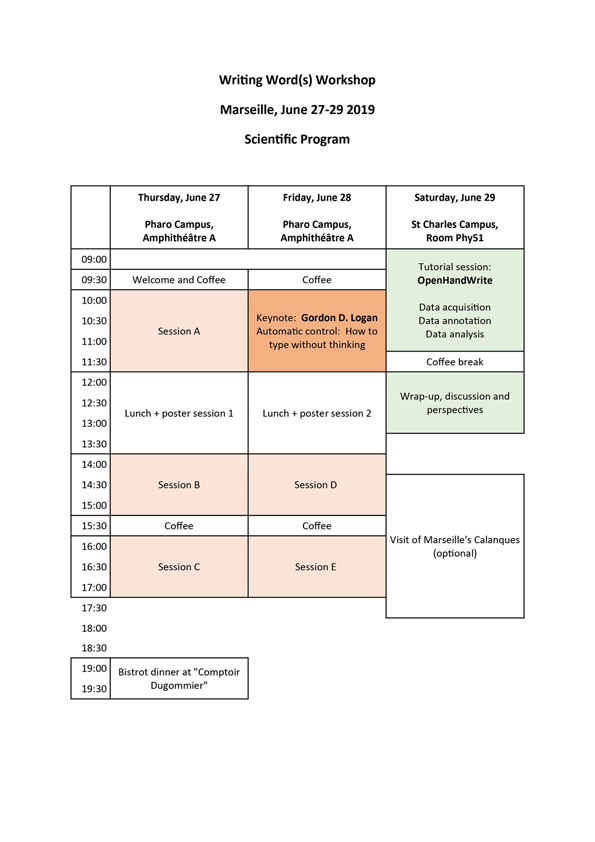
Schedule
Keynote Lecture
Automatic control: How to type without thinking Gordon Logan (Vanderbilt University, Nashville, USA)
Experts act without thinking because their skill is hierarchical. A single conscious thought automatically produces a series of lower-level actions without top-down monitoring. I will present a theory that explains how automatic control is possible in skilled typing, where thinking of a word automatically produces a rapid series of keystrokes. The theory assumes that keystrokes are selected by a context retrieval process that matches the current context to stored contexts and retrieves the key associated with the best match. The current context is generated by the typist’s own actions. It represents the goal (“type DOGS”) and the motor commands for the keys struck so far. Top-down control is necessary to start typing. It sets the goal in the current context, which initiates the retrieval and updating processes, which continue without top-down control until the word is finished. The theory extends to other sequential skills, like texting or playing music. It provides new insights into mechanisms of serial order in typing, speaking, and serial recall.
Session A: chair: Olivia Afonso - A. Molyneaux, A. Barnett, & V. Connelly – “Spelling strategies in copied and self-generated writing.” - S. Palmis, J.L. Velay, M. Habib, J.L. Anton, B. Nazarian J. Sein, M. Longcamp – “Development of the handwriting network: A coupled fMRI and kinematics study in middle-age children” - F. Bara – “From manuscript to cursive: Does the font matter in the first years of reading and handwriting acquisition?” - S. Hurschler, W. Wicki,& P. Falmann – “Gender differences among third graders’ writing bursts.”
Session B: chair: Mark Torrance - O. Afonso, & C.J. álvarez – “Constituent frequency effects in the written production of Spanish compound words.” - C.J. álvarez, Y. Hernández-Gálvez, & O. Afonso – “Influence of the syllabic structure of L1 when writing words in L2.” - J. Ernst, E. Belke, & S. Kandel – “Handwriting in German: Processing units, statistical influences and orthographic phenomena”
Session C: chair: Marieke Longcamp - M. Mccloskey, K. Wong, & G. Ellenblum – “In what sense are graphic motor plans effector-independent?” - C. Younes Harb, C. Matta-Abizeid, J.M. Albaret, J.L. Velay – “Handwriting analysis in bigraphic subjects writing French and Arabic”. - Y. Yang & H.Y. Bi – “Functional connectivity underlies gender differences in writing.”
Session D: chair Eva Belke - R. Laarmann-Quante, S. Dippe, & E. Belke – “What makes a word difficult to spell and for whom? A corpus-based study.” - C. Solier – “Spoken-written language interface in L2 language acquisition. The influence of orthographic input on phonological representations: the case of Morroccan learners.” - M. Torrance, J. Roeser, T. Baguley, M. Andrews – “Semantic and lexical effects on within-word production timecourse in typed object naming.”
Session E: chair F-Xavier Alario - K. Neophytou, R Wiley, K Tsapkini, B Rapp– “Spelling as a single classification task in primary progressive aphasia: Theoretical and practical implications.” - S. Pinet & N. Nozari – “The role of visual feedback in detecting and correcting typing errors: a behavioral and electrophysiological investigation.” - J. Roeser, M. Andrews, M. Torrance, T. Baguley – “No scope for planning – latent mixture modelling of keystroke latencies.”
Poster Session 1 - C. Mayer, S Wallner, N. Budde-Spengler, M. Kiefer, P. Arndt – Does the writing instrument (pencil, tablet stylus or keyboard) affect letter recognition in kindergarten children? - N. Bonneton-Botte, A. Cherbonnier, N. Girard, E. Anquetil, E. Jamet – Can tablet apps support the handwriting learning? An investigation of learning outcomes in kindergarten classroom. - T. Cerni, M. Longcamp, & R. Job – Two thumbs and one index: A comparison of manual coordination in touch-typing and mobile-typing. - C. Fitjar, M. Torrance, G. Nottbusch, V. Rønneberg – Children’s letter writing automaticity at school entry. - Y. Hernández-Gálvez, O. Afonso Hern ́andez & C. Javier Alvarez Gonzalez - Writing cognate word: Is there automatic activation of translation equivalents? - E. Lambert & M. Gimenes – Is spelling memory improved by reading aloud? A study with fourth and seventh grade students, and adults. - B. Laroche, C. Perret, & T. Olive – The role of visual feedback in written word production: A topographic ERP Analysis.
Poster Session 2 - T. Olive & S. Bouriga – The cognitive demands of handwriting and of typing in university students. - S. Pinet, C. Zielinski, M. Longcamp, F.X. Alario – How well do university students type? Linking typing habits to proficiency in an academic population. - Q. Qu & M. Damian – Facilitation and interference in written word production: Evidence from a Chinese blocked cyclic task. - M. Scaltritti, C. Suitner, & F. Peressotti – Beta-band desynchronization in reading and typing. - C. Soum-Favaro, C. Solier, & S. Hoquet-Pacaud – Writing in dyslexia: Produce sentences in a dictation task. - L. Véron-Delor, S. Pinto, A. Eusebio, J.L. Velay, J. Danna – Does handwriting sonification help Parkinson's patients to write words?
Tutorial session, hands-on: G. Nottbusch, S. Heß, & M. Torrance – “OpenHandWrite” - three step session: * Data acquisition with OHW GetWrite * Data annotation with OHW MarkWrite * Data analysis with R
|


